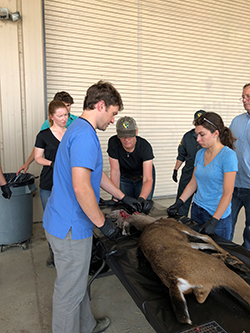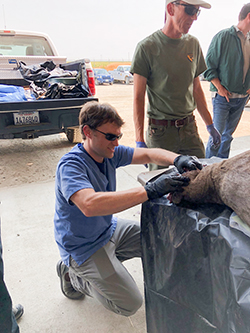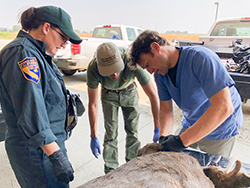
Veterinary staff assess deceased deer

Veterinary staff take samples of deceased cervid

Veterinary staff take samples of deceased cervid
CDFW scientists, wildlife officers and other staff are pulling out all the stops to fight a wildlife disease of major concern from crossing state lines and infecting native deer and elk populations.
Chronic Wasting Disease (CWD) is a contagious, always-fatal neurological disease that affects cervids (deer, elk and moose). In North America, the disease is currently found in captive and wild cervid populations in 24 U.S. states and two Canadian provinces. It has been detected in captive elk and sika deer in South Korea and free-ranging reindeer, moose, and red deer in Norway and Finland.
To date, a combination of legislation and geography have kept this disease at arm’s length from California, but the threat is still very real.
“All of us – scientists and wildlife managers, landowners and hunters – need to join forces and work together to keep this disease out of California, or the future could be disastrous for our native herds,” said CDFW Wildlife Veterinarian Brandon Munk, who participates in a multi-agency task force to fight CWD.
For California, this means two things: continuing to enforce strict cervid (animals and parts) importation and movement regulations, and ramping up disease surveillance efforts. This deer season, CDFW will be setting up voluntary check stations for deer hunters throughout California. Here trained staff will collect lymph nodes from the neck of harvested deer – a process that takes only minutes and is minimally invasive to the surrounding tissue. While waiting, hunters can get their tags validated and learn more about how to help prevent the introduction of CWD to California.
Once established, CWD is notoriously difficult to fight. The disease is spread by direct contact with infected animals or environments contaminated by the infectious agent called “prions.” Environmental contamination seems to play a very important role in the spread and maintenance of this disease. Once the environment is seeded with these prions, eradication is difficult – if not impossible – as prions are extremely difficult to remove from the environment or to disinfect. Prions can also remain infectious in the environment for years. Even controlled burning and freezing temperatures do not remove the threat. Most attempts to eradicate this disease have failed, and scientists in other states have had limited success in their efforts to control its spread.
CWD is also difficult to detect, in part because the outward signs often do not manifest until several years after initial infection. Currently, there is no effective live-animal test and there is no vaccine. Systematic testing of hunter-harvested deer is one of the most widely used surveillance methods available. Additionally, it is one important method to help ensure the disease has not entered the state and will help ensure CDFW can detect CWD early should it ever reach California. Early detection of CWD is the first and most important step to effective management of this disease.
CDFW has established a Chronic Wasting Disease Task Force to lead efforts preventing the spread of CWD to this state. Members include CDFW staff (biologists, veterinarians, communications officers and wardens), Fish and Game Commission employees and California Animal Health and Food Safety veterinarians. The task force is reaching out to the public and other local, state, and federal agencies to help with surveillance efforts, educating sportsmen about how they can do their part to prevent the spread of CWD and preparing a comprehensive management plan to allow for rapid response if the disease ever does make it to California.
“We are very lucky that to date, no California deer or elk has tested positive for CWD – but we’re not taking it for granted,” Munk said. “We urge hunters to educate themselves about this very real threat, and to do their part to make sure that we keep it out of California.”
CDFW has produced a short video on preventing the spread of CDFW, including a demonstration on antler removal and proper butchering techniques. You can also find background information, additional links and updates on California’s efforts to fight CWD at www.wildlife.ca.gov/CWD.
To find a CDFW check station to get your deer or elk checked, please visit www.wildlife.ca.gov/CWD or call (916) 358-2790.
###
CDFW Photos. Top Photo: Veterinary staff takes and examines samples from deceased deer.